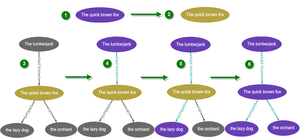Information
- Publication Type: Master Thesis
- Workgroup(s)/Project(s):
- Date: August 2020
- Date (Start): 23. January 2020
- Date (End): 20. August 2020
- Second Supervisor: Manuela Waldner
- Diploma Examination: 20. August 2020
- Open Access: yes
- First Supervisor: Eduard Gröller
- Pages: 122
- Keywords: Concept Map, Natural language processing, NLP
Abstract
Concept maps are a method for the visualization of knowledge and an established tool in education, knowledge organization and a variety of other fields. They are composed of concepts and interlinked relations between them and are displayed as a node-link diagram. Concept map mining is the process of extracting concept maps from unstructured text. The three approaches to mine concept maps are: manual, semi-automatic or fully automatic. A fully automatic approach cannot mirror the mental knowledge model, which a user would transfer to a manually created concept map. The manual process is often perceived as tedious and ineÿcient, limiting a wide-range application of concept maps. This thesis presents a semi-automatic concept map mining approach that tries to bridge the gap between all manual construction and fully automatic approaches. The advantage of this approach is that the users still have control over how their concept map is constructed, but are not impeded by manual tasks that are often repetitive and ineÿcient. The presented approach is composed of an automatic text processing part, which extracts concepts and relations out of an unstructured text document and is powered by state-of-the-art natural language processing and neural coreference resolution. The second manual concept map creation part allows the creation of concept maps in a user interface and presents the extracted concepts and relations as suggestions to the user. In a user study, an implemented prototype of the proposed semi-automatic concept map mining approach was evaluated. Manual gold standard concept maps that were created by the users and concept maps created by a fully automatic tool were compared to concept maps that were created with the prototype, proving the usefulness of the process. Results show that concept maps created with the semi-automatic prototype are significantly more similar to the gold standard than the ones created by the fully automatic tool. Additionally, considerably improved eÿciency in creation duration and user satisfaction could be observed in comparison to the manual creation of the gold standard maps.Additional Files and Images
Weblinks
BibTeX
@mastersthesis{Presch_2020,
title = "Semi-Automatic Creation of Concept Maps",
author = "Christoph Presch",
year = "2020",
abstract = "Concept maps are a method for the visualization of knowledge
and an established tool in education, knowledge organization
and a variety of other fields. They are composed of concepts
and interlinked relations between them and are displayed as
a node-link diagram. Concept map mining is the process of
extracting concept maps from unstructured text. The three
approaches to mine concept maps are: manual, semi-automatic
or fully automatic. A fully automatic approach cannot mirror
the mental knowledge model, which a user would transfer to a
manually created concept map. The manual process is often
perceived as tedious and ineÿcient, limiting a wide-range
application of concept maps. This thesis presents a
semi-automatic concept map mining approach that tries to
bridge the gap between all manual construction and fully
automatic approaches. The advantage of this approach is that
the users still have control over how their concept map is
constructed, but are not impeded by manual tasks that are
often repetitive and ineÿcient. The presented approach is
composed of an automatic text processing part, which
extracts concepts and relations out of an unstructured text
document and is powered by state-of-the-art natural language
processing and neural coreference resolution. The second
manual concept map creation part allows the creation of
concept maps in a user interface and presents the extracted
concepts and relations as suggestions to the user. In a user
study, an implemented prototype of the proposed
semi-automatic concept map mining approach was evaluated.
Manual gold standard concept maps that were created by the
users and concept maps created by a fully automatic tool
were compared to concept maps that were created with the
prototype, proving the usefulness of the process. Results
show that concept maps created with the semi-automatic
prototype are significantly more similar to the gold
standard than the ones created by the fully automatic tool.
Additionally, considerably improved eÿciency in creation
duration and user satisfaction could be observed in
comparison to the manual creation of the gold standard maps.",
month = aug,
pages = "122",
address = "Favoritenstrasse 9-11/E193-02, A-1040 Vienna, Austria",
school = "Research Unit of Computer Graphics, Institute of Visual
Computing and Human-Centered Technology, Faculty of
Informatics, TU Wien",
keywords = "Concept Map, Natural language processing, NLP",
URL = "https://www.cg.tuwien.ac.at/research/publications/2020/Presch_2020/",
}

 Master Thesis
Master Thesis Poster
Poster teaser
teaser


